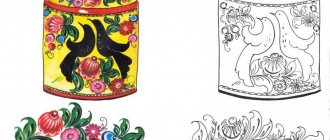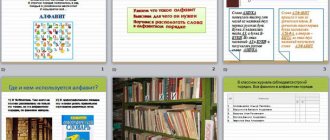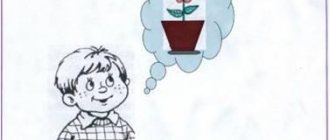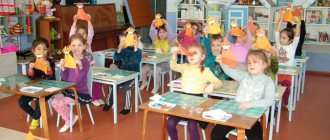Lesson summary “Why do people need water?”
Irina Kochetkova
Lesson notes “Why do people need water?”
Goal: to provide children with an understanding of water.
Objectives: to help children become familiar with some of the properties of water;
arouse interest in research activities;
contribute to the expansion of ideas about the importance of water in the life of humans , plants, and animals.
Preliminary work: viewing presentations about water, reading poems, stories about water, guessing riddles about water, experimental activities, film “The Journey of a Drop.”
Summary of a conversation with children of senior preschool age “The benefits of water”
Lesson summary “How important water is”
Purpose of the conversation:
formation of children's ideas about water and its role on Earth.
Tasks:
— consolidate children’s knowledge of why water is needed;
- develop coherent, dialogical and monologue speech of children, activate children’s vocabulary; continue to teach children to listen to a question to the end;
— cultivate cultural and hygienic skills; careful attitude towards water. Equipment:
globe, laptop, screen, projector, cards for the game “What will happen if the water disappears?”, magnetic board, flat images of the globe, basket for drawings, blue long ribbons and short and long ribbons.
Progress of the lesson
TEACHER
asks the children a riddle.
In the sea I am always salty,
but in the river I am fresh. Only in the hot desert I have no place at all
(water).
Water
- one of the most amazing substances on the planet.
TEACHER.
Water is needed to do many simple, everyday things.
She is irreplaceable. Do you think it is possible to live without water? Without water, a person cannot live long. TEACHER.
Is there anything else you would like to know about water?
Then you and I are going to the city of Knowledge (shows the globe to the children). TEACHER.
Do you know what this is?
(children's answers). TEACHER.
This is a globe - a model of planet Earth.
What is indicated in blue on the globe? (children's answers). TEACHER.
What other colors do you see?
What do these colors represent? (land). What color is there more on the globe? (twists the globe) What do you think this means? (children's answers). There is much more water on our planet than land. TEACHER.
Where in nature is there water?
CHILDREN.
In the seas, oceans, rivers, lakes.
TEACHER.
How are they different and what do they have in common?
(children's answers). TEACHER.
Is it possible to drink water from the sea and ocean?
Sea water contains many different salts that are produced by algae. It is useful to take baths with sea water and gargle with it. It strengthens the body, but is not suitable for drinking. What kind of water can you drink? (children's answers). We need clean, fresh water for drinking, cooking, and bathing. Where does fresh water come from? River water is called fresh water. River water is purified in a special place called a water treatment plant, after purification it enters our apartments through water taps. TEACHER.
Where is there more water - in the oceans or in rivers and lakes? What conclusion can be drawn from this? (Water must be conserved because there is little fresh water on Earth).
Physical education minute.
We quickly went down to the river,
bent down and washed ourselves. One, two, three, four - That's how nicely refreshed you were! And now we swam together, You need to do this with your hands: Together - once, this is breaststroke, One, the other - this is crawl. We swam along the river together, came out to the steep bank and waved our hand to her!
Game: “What happens if the water disappears?”
Let's imagine that the water on earth has disappeared. What will happen to plants, animals, humans?
Children's answers.
TEACHER.
Water is of great importance for life.
All living beings need it - animals, plants and people. It seems that there is a lot of water on earth, but clean water is becoming less and less. Why do you think this is happening? Children's answers. TEACHER
.
People break the rules of behavior in nature. Water bodies are polluted not only by garbage, but also factories and factories pollute rivers with waste from their production. Aquatic life is dying from this. The sea coasts are strewn with garbage, people dump huge amounts of toxic substances into the seas and oceans, tanker accidents leave sticky oil slicks on the surface of the water, all this is destroying the water. There are countries on the planet where clean water is no longer enough, so on March 22, people all over the planet celebrate World Water Day. His motto: “Water is life.” We must conserve water so that there is enough for everyone. TEACHER.
What measures need to be taken to ensure that the water does not leave us and is clean?
CHILDREN.
Don't throw trash.
You must treat water with care and do not leave taps open. Keep rivers, lakes, seas, ponds clean and tidy, and do not litter natural bodies of water. Install water purifiers. TEACHER.
There are many different rivers on earth - they are big and small, and they all run somewhere, a big river is formed from many small rivers and streams.
And it is very important to preserve the water of small and large rivers from pollution. TEACHER.
Let us draw clean oceans, seas, rivers and hang the drawings on the board so that they remind us of the need to save water. TEACHER.
What wonderful drawings you have made.
What would you like to say to other people00? CHILDREN'S ANSWERS
(People, plants, animals, birds need water. Our earth and all life on it will die without water. Water in both rivers and seas must be preserved and protected so that disaster does not happen).




